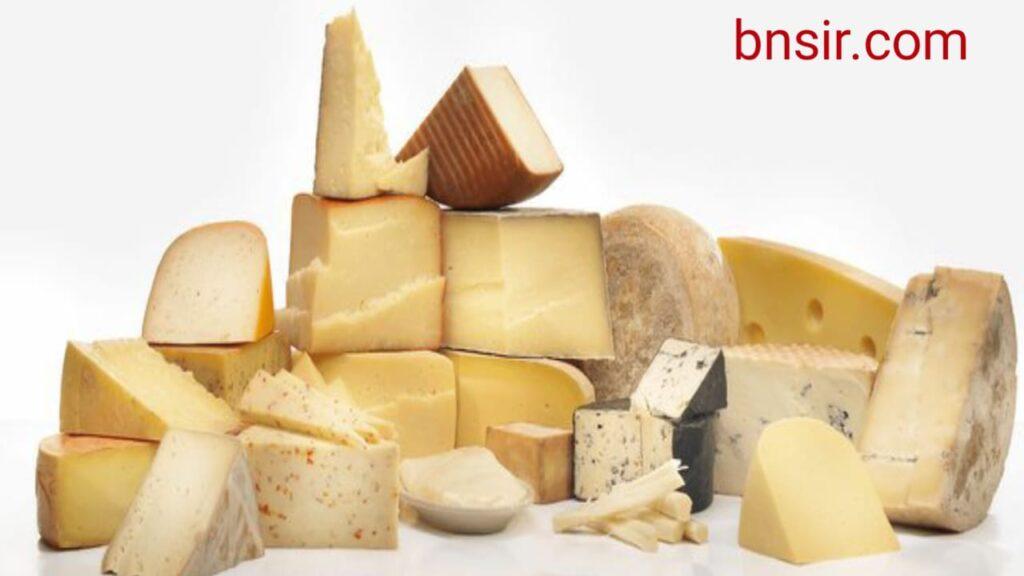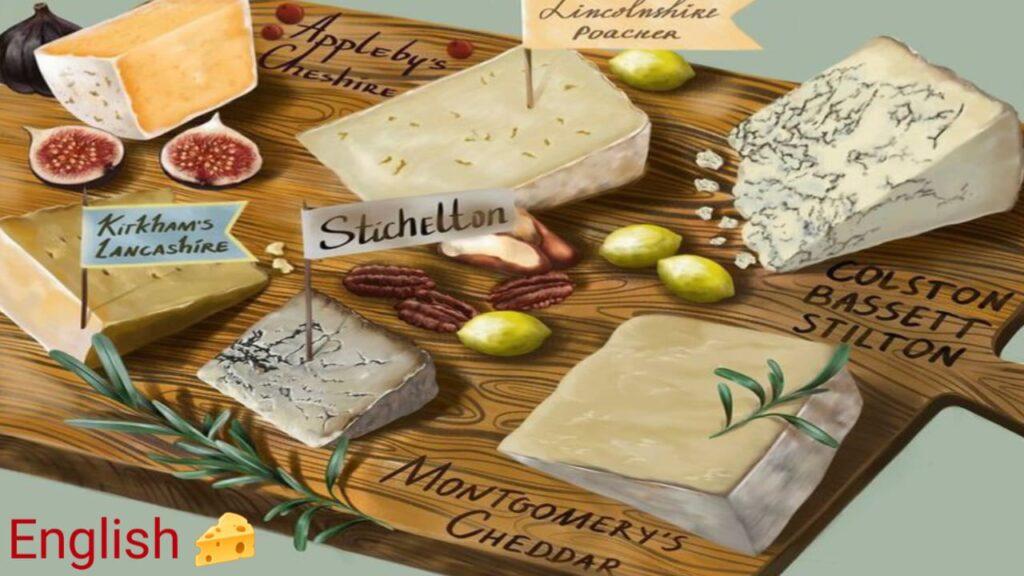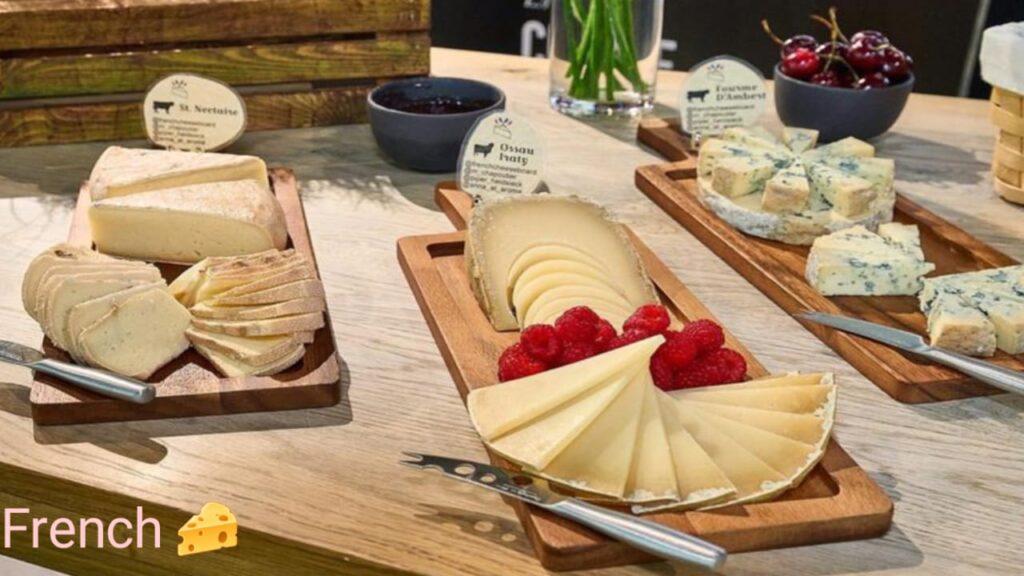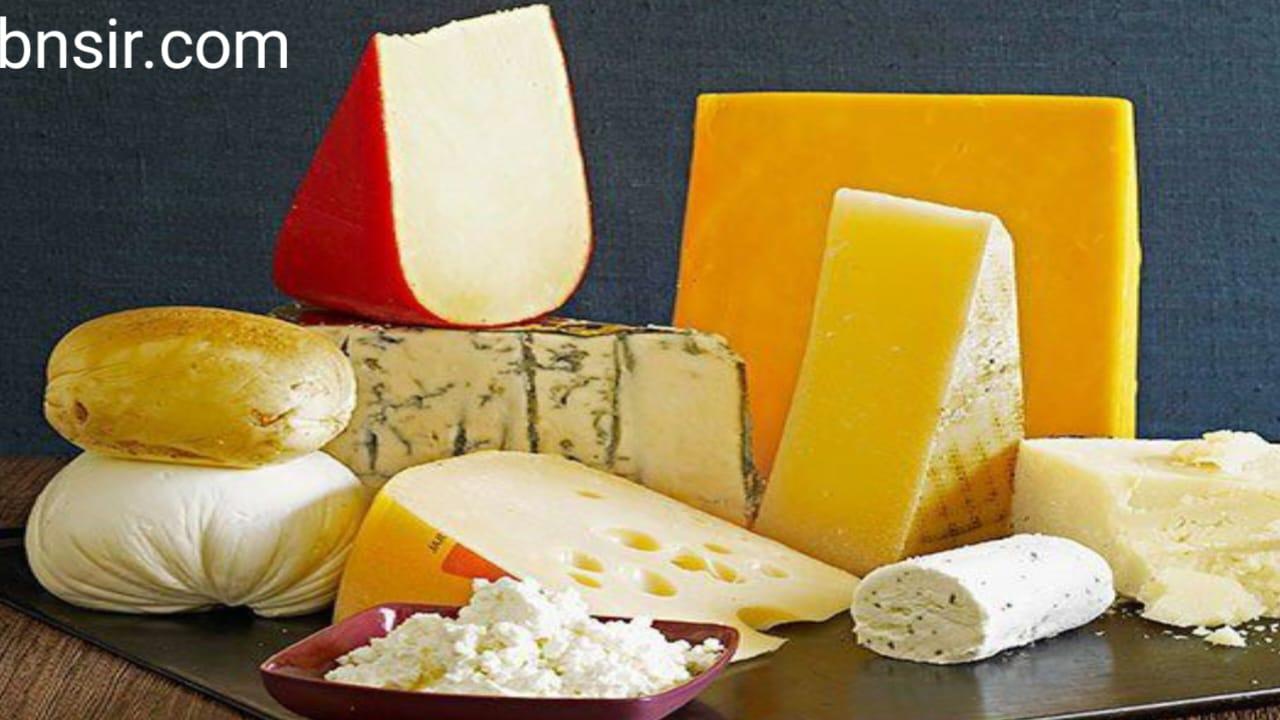CHEESE: It is a milk product and is made primarily to utilise the seasonal excess produce of milk by variety of processes for preservation. The basic means to produce cheese is to remove the substantial quantity of water by curdling. The use of any acid or enzyme, natural or artificial are used for curdling.

Each country claims to have their unique variety although Europeans are more recognised cheese makers for international markets. In most cases the enzymes from calf’s stomach rennet is used for digestion of milk, further more liquid is removed by putting pressure on the soft unripened cheese and various colouring, flavouring, spices, moulds, preservatives are added and matured for different duration of time depending upon the type of cheese.
Most of cheeses sold in international market are branded, although imitations are also available in abundance.
Cheese according to hardness and rind:
Soft white
Bloomy-rind
Washed-rind
Pressed uncooked
Pressed cooked
Blue-mould
Natural-rind
Processed
Soft White
This is the simplest type of cheese. They are neither fermented nor matured. Their high moisture content, coupled with the high humidity, attracts and encourages the growth of the classic white penicillium mould. This type of cheese is creamy and smooth. They are based on cow’s milk, skimmed or unskimmed and sometimes enriched with cream.
Bloomy-rind
These cheeses are neither pressed nor cooked. They are salted and seeded with Penicillium candidum that gives them their bloom (the white down that takes on a golden aspect as it ages)
Washed-rind
The curd, which may or may not be cut depending on how soft the final cheese should be, is scooped into moulds and left to drain. The high moisture of the curd and the humidity of the maturing rooms attract a bitter-tasting, grey, hairy mould called “cat fur”.
They are raw or pasteurized milk cheese that come from the north of France, the east of Belgium, Luxembourg and the western marches of Germany. The maturation period lasts from two to six months, then the chesses are washed in slightly salted brine. These cheeses are rather spicy and outrageously piquant in taste and aroma. They can smell yeasty or almost meaty.
Pressed, uncooked
For this type of cheese the raw or pasteurised milk is heated to 36° C and coagulated at a slightly lower temperature. The curds are fragmented into tiny particles the size of rice grains and pressed through cloths to extract the whey. The maturation takes two or three months. The rind is brushed to obtain a regular patina and prevent patches of humidity.
Pressed, cooked
Hard pressed, cooked cheeses are virtually identical to the semi-hard, pressed, cooked cheeses. These cheeses are made using the evening’s milk, left to stand overnight and skimmed, mixed with bat of the next morning. Maturation takes place in a cool, humid cellar, and lasts four to ten months, during which the cheese is washed in a low-salt brine and scraped.
Blue-mould
The blue mould is a strain of penicillium that is added to the milk before the rennet is added either in liquid or powder form. Most blue cheeses are normally wrapped in foil to prevent them from dying out. They are neither pressed nor cooked. They are usually made from cow’s milk.
Natural-rind
These are mainly goat’s and sheep’s cheeses. When young, they have a slightly wrinkled, cream coloured rind. In time they dry out, the wrinkles become more pronounced and the character and flavour increases, along with the growth of bluish grey mould. Their taste is fresh, almost fruity, with undertones of goat. To mature, these cheeses must be kept dry.
Processed
These are the results of melting one or more pressed, cooked or uncooked cheeses, and adding milk, cream, butter and sometimes flavouring agents. One or several ripened cheeses are heated and mixed, then pasteurized at high temperature (130°-140° C) after other dairy products, such as liquid or powdered milk, cream, butter, casein, whey, and seasoning have been added.
ENGLISH CHEESES

- Cheshire: It is made from cow’s milk. It is cylindrical full cream hard pressed cheese, texture being loose and flaky, flavour mild or mellow available in white, red or blue colour. It is generally coloured with annato or carrot juice.
- Cheddar: It is made of cow’s milk. It is cylindrical in shape. It has hard texture being porous, flavour being full and nutty but not strong, may be coloured with carrot juice.
- Stilton: It is made from rich milk and cream. It is blue veined, semi-hard, mould ripened seasonal cheese because it is innoculated with a mould the Penicillium glaucum, which is responsible for blue veining.
- Caerphily: Originally a Welsh, semi-hard cheese popular amongst the miners of Wales and South of England. It has mild flavour, creamy white colour. It ripens within a fortnight.
- Derby: It is hard pressed cheese, cylindrical in shape matured for 6 months. It has pale honey colour.
- Gloucester and Double Gloucester: It is a hard cheese made from cow’s milk. It is mixed with some beer during 1″ month of maturation, which gives it pale vermilion colour. It is matured for at least six months
- Lancashire: It is semi-hard cheese, flattish in shape having mild flavour, but somewhat acidic when 2-3 months old but becomes mellow with age. 8. Leicestershire: It is hard pressed cheese with flaky texture, rosette colour. It is coloured by addition of annato.
FRENCH CHEESES
France has a great variety of cheeses. This is due to the fact that there are so many different climatic conditions in France, also different kinds of soils and breeds of cows, other milk givers like goat and ewe etc.

CREAM CHEESES
- Fromage Blanc: This is a cream cheese from unskimmed sour milk. It’s eaten with salt and pepper. It is eaten with cream poured over it, then castor sugar is passed.
- Demi Sel: It is a small, paper wrapped fresh cream cheese, about 4 oz in weight. It’s salt content must be 2 per cent, butter fat content not less than 40 percent of its weight as per official regulations.
- Petit Suisse: It is a paper wrapped, unsalted, cylindrical, fresh cream cheese weighing approximately 60 grams. It is made of whole milk to which fresh cream is added. Its butter fat content should be 60 percent of its total weight.
- Saint Marcellin: It is named after the village where it is made. It is a soft cream cheese with 50 percent fat content made from both goat’s and cow’s milk mixed.
SOFT CHEESES
- Brie: It is named after Province of La Brie, immediately to East of Paris, along the lower valley of the Marne. Its shape is circular, its thickness varies from ¼ inch to an inch. It is soft paste cheese made from renneted cow’s milk, not heated, not pressed, slightly salted without any rind but a reddish-brown mouldy crust with white tracings.
- Camembert: It is the name of one of the most universally known cheeses in the world. It is soft paste, round cheese, made of cow’s milk, neither skimmed, nor heated, nor pressed but fermented after it has been inoculated with Pencillium candidum a white mould.
- Pont l’ Eveque: It is a soft cheese, made out of cow’s milk unskimmed and the milk of one milking only, renneted, allowed to ferment by mould called Monilia candida which imparts distinct flavour in to this.
- Neufchâtel: It is a soft, whole milk cheese, lightly pressed and lightly salted, packed in tin moulds of different shapes, allowed to stay in cellars for months till it gets covered with a white, velvety mould. It weighs about 4 oz. Although it is eaten when ripened in Europe, i America it is eaten fresh.
SEMI HARD CHEESES
- Port du Salut: It is a semi-hard cheese made from cow’s milk. It was made by monks of the Abbey at Entrammes.
- Munster: It is the national cheese of Alsace. It is made of cow’s whole milk and is a semi hard cheese with minimum 45% fat content. It is round having 4% inch-7 inch diameter, 1% inch to 2 inch height and weighs 10 oz to 2 lb.
- Géromé: It is a cylindrical, softish fermented whole milk cheese with a fat content of 40% of its total weight, usually ripened in cellars for about 4 months. It is sometimes flavoured with fennel, aniseeds or cumin seeds. It has strong flavour. The rind is brick red, the paste yellow.
- Saint Nectaire: It is a semi hard cheese made from cow’s milk having a shape of flat cylinder, matured on rye straw mats in deep cellars which are always cool and damp. The cheese acquires a colourful mouldy crust of white, yellow and red in those cellars.
BLUEVEINED OR MOULD INNOCULATED CHEESE
- Roquefort: Roquefort is made from ewe’s milk and it is the only ewe’s milk cheese that has won international recognition. It is made from unskimmed morning and evening milk mixed and renneted with rennet from lamb’s stomach which is added to milk when temperature is raised to 90°F. To the coagulated milk a layer of mouldy breadcrumb having culture of Penicillin glaucum is put. After salting and pressing it is matured in the caves of Roquefort where temperature is about 46°F and humidity high due to existence of an underground lake. It is impossible to make Roquefort anywhere else.
- Epoisses: Epoisses is one of the best blue veined cheese of côte d’ or (Burgundy). It is whole milk, mould innoculated soft cheese in a shape of a cylinder with flattened end about 5 inches across and 3 inches thick. It is eaten fresh during summer. It is flavoured with black pepper, clove or fennel seeds.
ITALIAN CHEESES
- Gorgonzola: Gorgonzola is the name of village near Milan. It is an Italian blue veined cheese, made in cylindrical shape or round shape weighing about 8 kg. The cheese has a strong rich taste and is good for desserts, snacks and salad dressing.
- Mozzarella: An Italian unripened, curd cheese originally made from buffalo’s milk, but now obtained exclusively from cow’s milk made in various shapes such as round and slabs. It is widely used as cooking cheese for pizza, lasagne and toasted sandwiches.
- Parmesan: One of the Italy’s best known cheeses, is one of the granular types. It is made from cow’s milk made in a large wheel and matured for 2-3 years.
- Pecorino: Pecorino is a generic name for all those cheeses which are made from ewe’s milk. It is hard cheese eaten fresh or grated when fully matured, used in many pasta style dishes.
- Fontina: A cow’s milk cheese from Italy, has a delicate nutty, slightly smoky taste and is used for making Fonduta (an Italian version of Swiss Fondue). It is made in flat wheel shapes.
- Ricotta: An Italian fresh, unripened cheese made from the whey of cow’s milk. It is smooth and mild tasting, used in a variety of sweets and savoury dishes, including pizzas. It is packed in various shapes and sizes.
SWISS CHEESES
- Emmentaler/Emmenthal: The world’s famous Swiss cheese made from cow’s milk has a sweet, nutty taste. It is available in wheel shape. Its weight is between 154-176 lb. Diameter is 27 inches to 31 inches and height 5 inches to 10 inches. It has holes or eyes which vary in size between a cherry and walnut. The rind is dry and hard from golden yellow to brown in colour.
- Gruyère: This is a famous cow’s milk cheese from Switzerland. Its weight is between 44 lb to 110 lb, diameter between 16 inches-25 inches and height between 3½ inches and 5 inches. It has holes or eyes which vary in size between a pea and hazelnut.
- Raclette: A cow’s milk cheese from Switzerland with a mild, nutty taste made in wheel shape.
- Sbrinz: A swiss hard cheese made from cow’s milk made into wheel shape. The eyes are absent or are only the size of a pinhead.
GERMAN CHEESE
- Bavarian Blue: A double cream soft textured, blue veined cheese from West Germany, made from cow’s milk has a creamy texture, spreads well on sandwiches. It is made in small wheel shapes.
BELGIUM CHEESE
- Limburger: It is a ripened cheese made from cow’s milk. It is rectangular in shape made from sweet milk, ripened for 1-2 months having strong smell. It is a native of Belgium. Now it is national cheese of USA.
DUTCH CHEESES (Netherlands)
- Gouda: A famous Dutch cheese made from cow’s milk. It is flat, cylindrical cheese having smooth and compact rind. It is straw yellow in colour. It has small irregularly shaped or round holes evenly distributed.
- Edam: It is a famous Dutch cheese made from cow’s milk spherical in shape with flattened top and base coated with red wax. The paste is yellow or light orange. It is known as Dutch Red Ball in England.
- Leyden/Leiden: A Dutch semihard cheese covered with a dark yellow rind, then with red wax, made from whole or skimmed cow’s milk flavoured with caraway or cumin seeds. It is served as a snack.
PANISH CHEESES (DENMARK)
- Danish Blue: A Danish cheese made from homogenised cow’s milk, soft textured and creamy with a fairly strong taste and makes a good dessert cheese. It is made in wheel shapes.
- Mycella: A Danish cheese made from cow’s milk. It has blue green veins. It is mould Mycelium which produces the veins. It is available in cylindrical shape.
- Blue Castello: A Danish blue cheese double cream soft textured cheese made from cow’s milk.
NORWEGIAN CHEESES (NORWAY)
- Jarlsberg: A Norwegian cheese ranging from white to light yellow with large holes scattered throughout. It is made from cow’s milk and has a firm buttery interior and a mild nutty taste. It is covered with a thick rind, then with a yellow wax. It is made in wheel shape.
- Gjetost: A Norwegian whey cheese can be made from cow’s milk or goat’s milk. It is made in cubes or rectangular block. It has fudge like taste.
SPANISH CHEESES (SPAIN)
- Manchego: It is a Spanish semihard cheese made from ewe’s milk, has a creamy firmish textured interior, which sometimes has holes. It has strong taste.
- Cabrales: It is made from goat’s milk made in cylindrical shape, has a strong pronounced taste.
- Roncal: It is a hard smoked cheese made from cow’s milk. It is cylindrical in shape, yellow in colour having small eyes and sharp flavour.
GREEK CHEESE (GREECE)
- Feta: A greek cheese made from ewe’s milk, has a sharp, salty taste used in savoury stuffings and salads.
AMERICAN CHEESES
- Brick: It is a sweet curd, semi-soft cow’s milk cheese with a mild, rather pungent and sweet flavour. It has irregular shaped eyes (holes).
- Colby: A popular American cheddar type cheese, a washed curd cheese having granular texture, high moisture content.
- Monterey Jack: An American semihard cheese from California made from cow’s milk has a bland taste, a smooth and open texture. It is made in block shapes or large wheels.
SCOTTISH CHEESES (SCOTLAND)
- Caboc: A Scottish double cream soft cheese made from cow’s milk and rolled in oatmeal, has a sweet flavour. It is made in cylindrical shape.
- Dunlop: A Scottish semihard cheese made from cow’s milk, is a cheddar type of cheese with rather bland and buttery taste.
Service of Cheese
Its comes in different containers, wrappers and coatings, in different shapes and sizes. It is a wonder food which is used in almost all courses and times. E.g cheese as an hors d’œuvre simply cut into small pieces to enhance the appetite appears on Horsd’œuvre trays and trolleys. The exquisite hot cheese soufflé as an appetizer is a classical french hors d’ ceuvre.
It is also served as an accompaniment with many soups e.g. Minestrone and French onion soup. The famous swiss cheese fondue in which molten cheese is used for an unique fritter in which cheese gets hardened on immersion, over the meat and vegetable pieces and cubes of stale bread. Cheese sandwiches and snacks are available in plenty in form of mini meal and snacks.
Last but not the least cheese as a course is so well known that people underrate its other uses. In many schools of thought cheese is best served after sweet or entremet course to change the taste left behind by the sweet. The typical method of serving cheese requires sufficient paraphernalia like
a) Mirror top or cheese Board
b) Cheese Trolley
c) Cheese knife
d) Sugar dredger
e) Cruet set
f) Butter dish
Accompaniments
- Celery sticks
- Radishes
- Assorted cream crackers and cheese biscuits
- Watercress
- Castor sugar with cream cheeses
- Salt, pepper and mustard
Normally four different varieties of cheese are arranged on a tray like soft, semi hard, hard and blue veined. To give colourful and attractive appearance on the tray it is advisable to display Edam, Gouda or Cheshire. Boxes or cartons should be opened but not the foil, wrapper or the coating. Cut the cheese as demonstrated in the illustrations with the help of cheese knife. Care should be taken to offer outside and inside slices to all the individuals.
- Round cheeses are cut in wedges like a cake. 2. Cheeses bought in slices should be cut lengthwise.
The service of cheese requires great skill and experience because hard cheese requires strength and grip like Edam and Cheddar. They also have wax coating which the guest may expect to be removed. Here one requires fork to peel out the skin. On the other hand soft cheese has a metal foil that requires to be removed after portioning needs dexterity. A pair of service spoon and fork is very handy in assisting the service of cheese, as at times the beak of cheese knife does not hold the cheese.
CHEESE UNDERSTAND 2 EASY WAYS WITH THE YOUTUBE VEDIO

